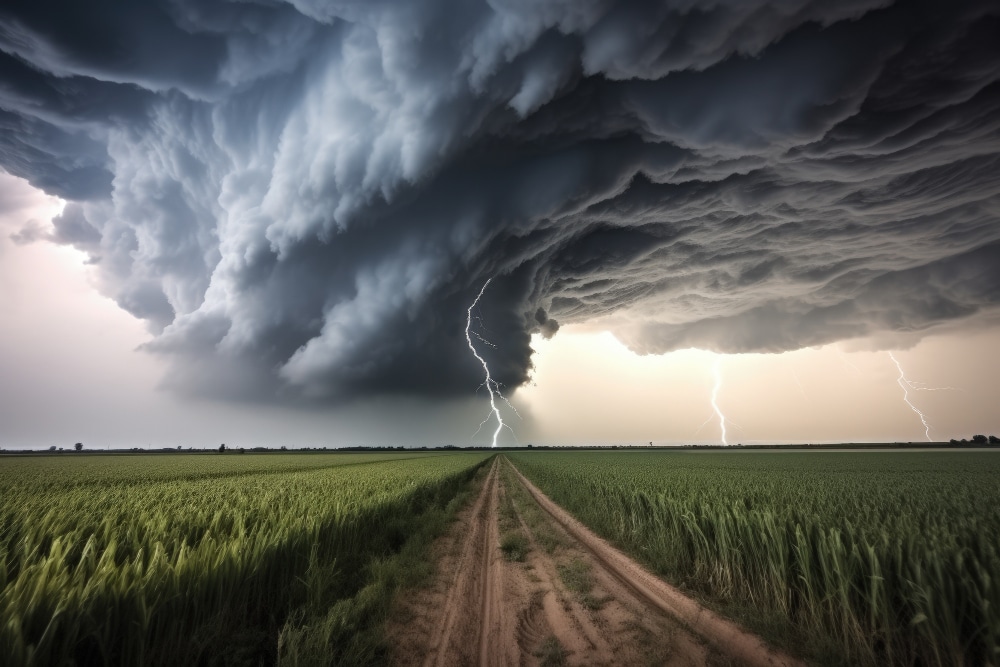In a time when climate change keeps reshaping our world, we need to understand how people around the globe view and react to extreme weather events. At Permutable AI, we’ve used our advanced natural language processing tools to analyse news sentiment data from across the world, giving unique insights into how different areas see and report on various aspects of extreme weather events.
It all started with a simple question: How do different regions perceive and report on extreme weather events? Our analysis looks at four main types of extreme weather events: natural disasters, heat waves, droughts, and general extreme weather conditions. By looking at news sentiment across these categories, we can learn a lot about global priorities, weak points, and responses to climate-related challenges.
Extreme weather events and natural disasters: A global concern with regional variations
Our heatmap for natural disasters shows a complex pattern of risk perception worldwide. Negative-sentiment areas (shown in red and orange) unsurprisingly cluster in regions that often face natural disasters, like the Pacific Ring of Fire, South Asia, and parts of North America.
First, let’s consider the headline counts. The United States, India, and China often top the headlines list, which reflects their size and how natural disasters can affect them. The United States remained at the top of our list in both August and September for perceived extreme weather risk, and much of this will have been in relation to Hurricane Francine which wrecked havoc in the states of Louisiana and Mississippi. Add to this that China has just experienced the strongest storm in 75 years, and India’s monsoon expected to be prolonged then we can see a clear picture building here.
One thing to note thought is that sentiment doesn’t always align with frequency. Keep in mind that how often a country makes headlines doesn’t always match up with how people feel about it. For example, while the U.S. has the most headlines, people’s feelings about it are pretty neutral compared to other countries.
In stark contrast, a few smaller countries such as Trinidad and Tobago display very negative sentiment despite having fewer headlines. This is almost certainly because when natural disasters strike these nations, they have a harsh and deeply newsworthy effect.
As for European countries, they exhibit lower sentiment levels, which is likely largely due to a mix of geographic factors and strong disaster readiness systems. Yet, nations like Greece and Italy do show medium risk levels due to their vulnerability to earthquakes and, for Greece, wildfires as well.
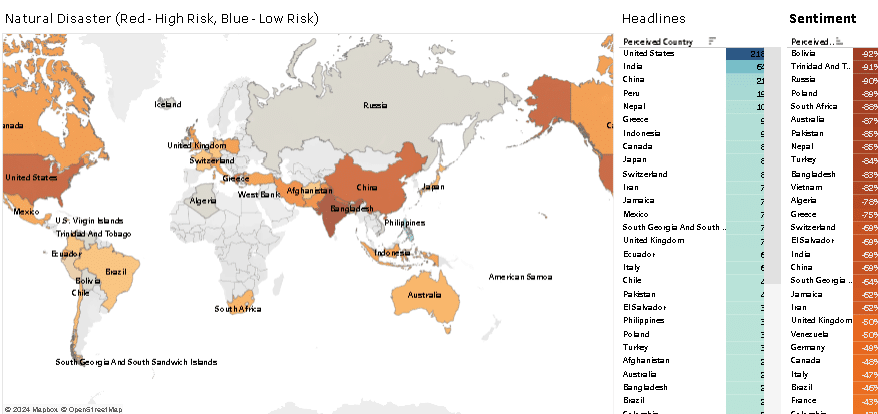
Extreme weather events and heat: A growing global threat
The extreme heat sentiment visualisation below shows a very different picture compared to the natural disaster map. Of course, we see obvious negative sentiment in countries which are typically linked with extreme heat, such as African and Middle Eastern countries. However, the sentiment analysis shows some interesting trends beyond this.
Take, for example, Luxembourg and Latvia have very negative sentiment even though they don’t make many headlines. In Luxembourg’s case, this is most likely in response to reports that the summer of 2024 was officially the hottest on record, surpassing last year’s temperatures as announced by the EU’s climate monitor, Copernicus. Meanwhile Latvia made the news for its Latvia experienced warmest temperatures on record in Spring, a surge in hospitalisations and drownings due its summer heatwave and most recently, record-breaking temperatures this September.
As with most things climate-related, the United States, again with the most headlines, has a more negative sentiment for heat news than for natural disasters. This might show that people are getting more worried about the heatwaves that are happening more often and getting worse across the country, which was very much illustrated by the extreme heat which hammered Southern California and the Southwest in early September.
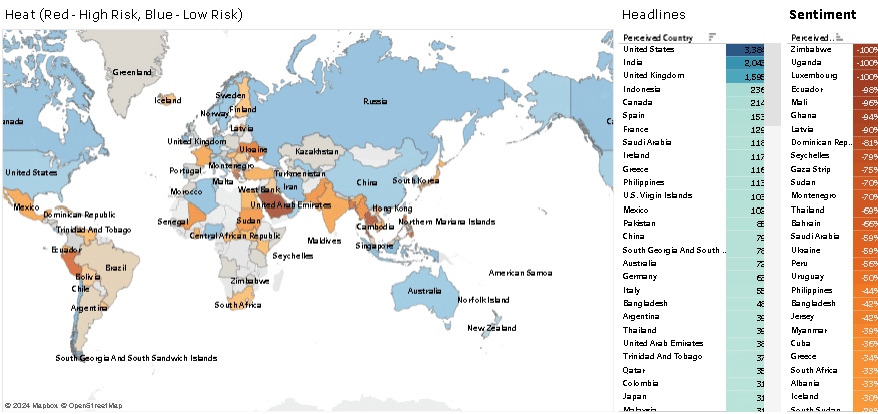
Extreme weather events and drought
The drought sentiment map shows negative areas spread out more around the world compared to the last two categories. This wide spread highlights that drought is a global effect of climate change.
It’s worth pointing out that big chunks of Africa, Australia, and South America are at high risk of drought, which lines up with what scientists predict about these areas getting drier because of climate change. Interestingly, the negative shown for Russia, likely sparked by when the country’s southern Rostov region declared an emergency due to drought, also indicates concern around how drought could affect its huge farming areas.
Places like Haiti and Guadeloupe show negative sentiment even though we don’t hear about them much in the news. This might mean that when droughts do happen in these Caribbean countries, they are hit hard even if they don’t happen as often.
The US tops the list for news mentions again, although this is likely skewed just by the sheer volume of news sources, but the tone is perhaps surprisingly, less intense than stories about heat or perhaps – even more curiously – natural disasters. It’s the same story on many environmental issues – frequency of discussion doesn’t always correlate with perceived urgency.
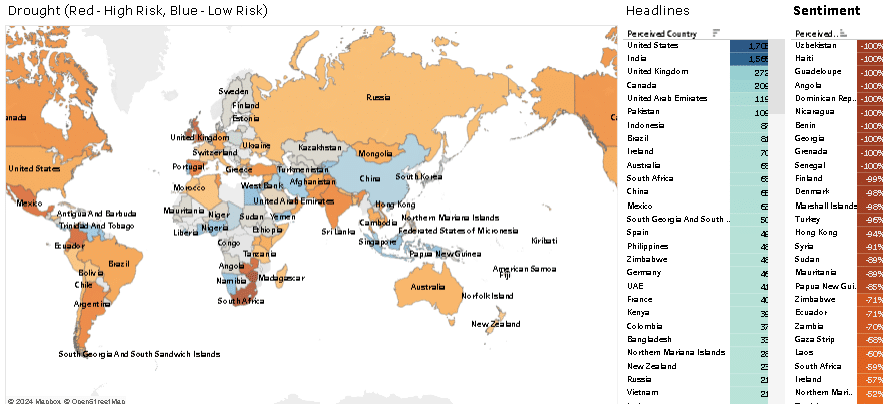
Extreme weather events: A big picture look
Now for the extreme weather sentiment map, which gives a full view of how people around the world see extreme weather events and climate-related dangers. This map shows high negative sentiment in a larger cross section of countries, showing how the global media perceives the impacts of extreme weather events and associated climate change affects in different ways.
Russia stands out with high negative sentiment. This might be a nod towards how extreme weather could hurt Russia, and how changes in the Arctic could affect the whole world. The sentiment analysis reveals some notable differences. Guinea displays a highly negative sentiment, as well as countries such as Libya, as it continues to deal with its vulnerability to floods, and Mauritania, which is often affected by a variety of hardships, including droughts, bushfires and heightened rainfall variability.
The United States, India, and the United Kingdom top the list in headline counts, highlighting these countries’ key roles in reporting on extreme weather events globally. Yet, their sentiment scores fall in the middle range, perhaps pointing to a more evenhanded approach to reporting on extreme weather events.
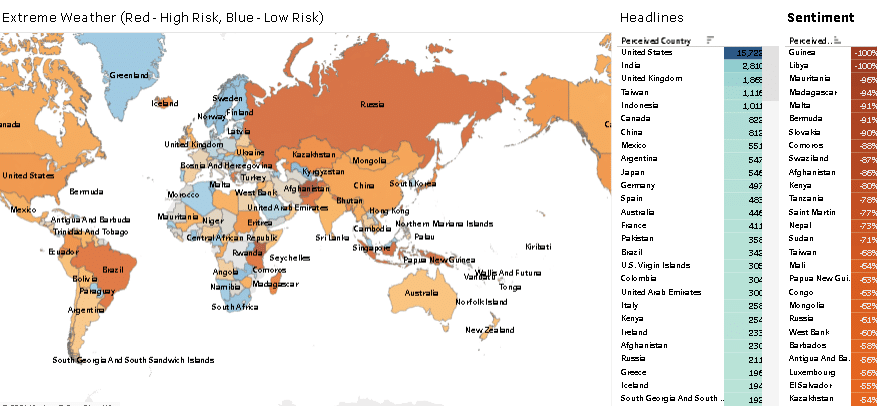
Extreme weather events news sentiment analysis: Summing up
These remarkable insights show us that the perception of extreme weather events a varies greatly across the globe. It is quite obvious to see that today, the concern for people in many parts of the world is not whether climate change is happening – as signified by these extreme weather events – but how to deal with its effects. All this means that we need a nuanced, region-specific approach to addressing extreme weather events and climate change. And that’s before we address the economic and social impacts of these extreme weather events as a major geopolitical risk.
From the reporting on extreme weather events globally, you get a sense that we’re at a turning point in global climate awareness. However, the real test is turning this awareness into real steps to build a stronger, more sustainable future for everyone. There’s a reason why understanding global news sentiment is crucial – it can be a powerful tool to shape policy, drives action, and ultimately determines our collective response to the climate crisis.
All of these points highlight the importance of continued research and analysis in this field. For now, we at Permutable AI will continue to refine our tools and methodologies to provide the most accurate and useful real-time insights possible. As so often in the face of global challenges, knowledge and understanding are our most powerful tools for change.
Unlock the power of global extreme weather events sentiment
The analysis you’ve just read offers a glimpse into the powerful insights available through our Extreme Weather Events Dataset. This comprehensive collection of global news sentiment data can transform how organisations understand and respond to climate-related risks and opportunities whether you are a financial institution, large multinational corporation or risk advisory looking to stay ahead in an increasingly complex risk environment. Whether you’re a policy maker, a business leader, or analyst our dataset offers real-time sentiment analysis from news sources worldwide, providing granular insights into perceptions of natural disasters, heat waves, droughts, and more.
To experience the full potential of this dataset and discover how our data intelligence can transform your decision-making processes, we invite you to request a free trial. Simply email us at enquiries@permutable.ai with the subject line “Extreme Weather Dataset Trial Request,” including your name, organisation, and a brief description of your data needs. Alternatively, fill in the form below.
